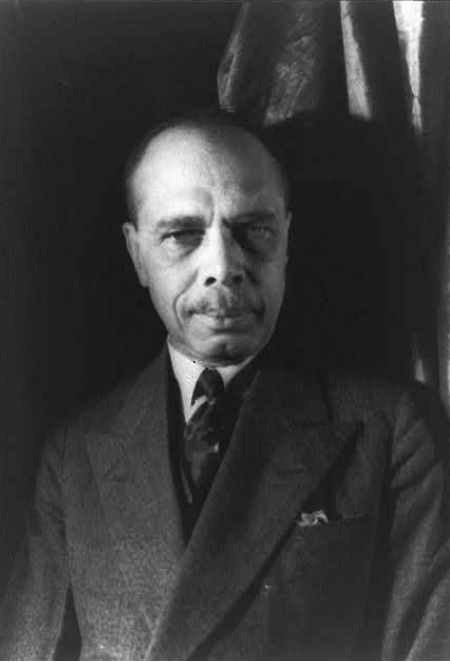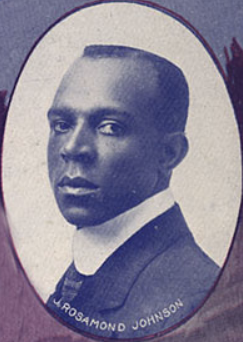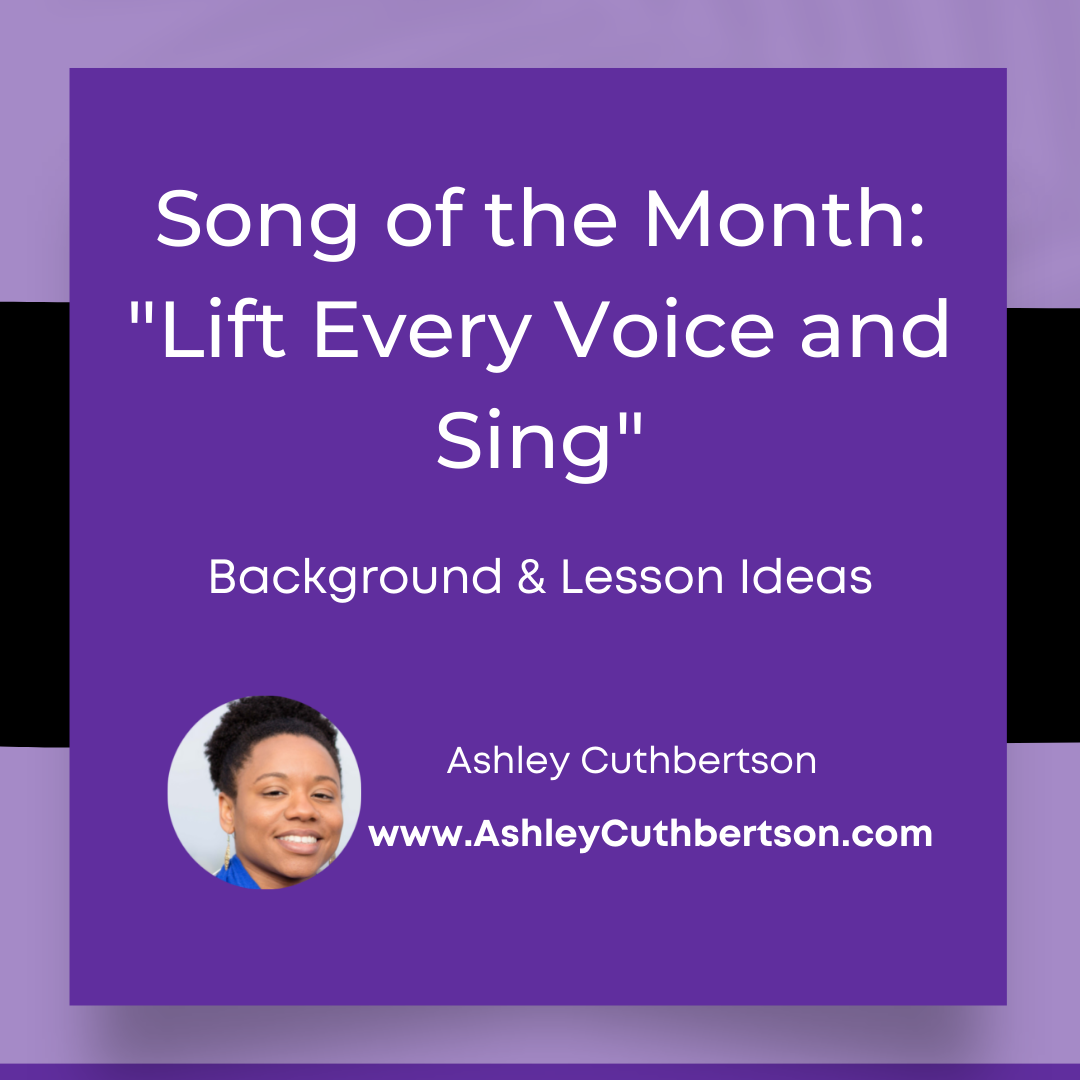Listen to this blog post by clicking on the player below!
In honor of Black History Month, today I’m continuing my monthly Song of the Month Series with “Lift Every Voice and Sing”! An important song every one of us should know, and a song that personally holds a lot of significance and memories of my own childhood.
The Black National Anthem
James Weldon Johnson wrote “Lift Every Voice and Sing” as a poem. His brother, John Rosamund Johnson, later set it to music and the song was first performed by 500 school children at James Weldon Johnson’s school where he was principal on February 12th, 1900 in a celebration of Abraham Lincoln’s birthday.
The song became very popular and spread, becoming known as the unofficial, then official Black National Anthem when it was adopted by the National Association for the Advancement of Colored People (NAACP) in 1919.
Written during the Jim Crow era, the powerful lyrics of the song both recognize the dark past of African-Americans in the U.S. while also being hopeful for the future.
The song became a rallying cry for the Black community, but it’s influences reached beyond those boundaries into Southern white churches, South America, and other countries around the world.
The Johnson Brothers

James Weldon Johnson (1871-1938) was born in Jacksonville, Florida and had a multifaceted career in education, law, music, as a diplomat, as a well-published author, in the Harlem Renaissance, and as a Civil Rights leader.
After graduating in 1894 from Atlanta University, Johnson returned to Jacksonville where he was a teacher and later principal of Stanton Elementary School, a school for Black students. While at Stanton, he began studying law, and in 1898 became the first Black man admitted to the Florida Bar since Reconstruction.
In 1901, he moved to New York City to write music for musical theater with his brother. Together, they composed about 200 songs for Broadway. In New York, Johnson became an important figure in the Harlem Renaissance and made many connections which later led to his career in diplomacy.
After serving as the US consul in Venezuela and Nicaragua, he joined the Civil Rights movement as field secretary for the NAACP in 1916, and became the executive secretary in 1920. After serving the NAACP for over a decade, he resigned to teach creative writing at Fisk University.

John Rosamund Johnson (1873-1954) was an important figure in Black music in the first part of the 20th century. He led a varied career as a pianist, songwriter, producer, soldier, singer, and actor.
Born in Jacksonville, Florida, he began playing piano at age four and studied at the New England Conservatory, and with Samuel Coleridge-Taylor in London.
In 1900, he moved to New York City to focus on his musical life. He often collaborated with Robert Cole, and his brother, James Weldon Johnson. His collaborations with Cole led to many vaudeville acts and songs, and two musicals, The Shoo-Fly Regiment (1907) and The Red Moon (1909).
When World War I broke out, Johnson served as a 2nd Lieutenant in the 15th Regiment. After the war, he toured with his own groups and acted, including playing the part of a lawyer in the original production of Porgy and Bess in 1935.
Lift Every Voice and Sing: Today
“Lift Every Voice and Sing” remains an important song in the Black community, and a song that all Americans should know. The song is widely performed at churches, schools, graduation ceremonies, sporting events, and more.
Learning the song provides us an opportunity to learn more about the history and culture of Black Americans as well as connect to current issues and movements such as Black Lives Matter and Prison Abolition. Additionally, this song affirms our Black students and Black history in the US while also opening the door for all students to develop understanding and empathy.
I have included a list of resources, references, and further reading below. I highly encourage you to dig into those resources and seek out additional ones to expand your own mind and develop a better understanding of this song, it’s meaning, and it’s context.
Lesson Ideas for “Lift Every Voice and Sing”
There are so many directions a lesson or unit plan with “Lift Every Voice and Sing” could go!
Here are just a few ways you can teach “Lift Every Voice and Sing” through the artistic process (Respond, Connect, Perform, Create):
Respond
Students will…
- Describe musical elements
- Identify AB form and verse
- Compare and contract versions of the song using musical elements
- Discuss lyrics and their meaning
Connect
Students will…
- Learn the background of the creators and explore their intent for writing it
- Explore the experiences of Black Americans over time
- Explore what brings them hope during difficult times
- Consider the role of anthems in propaganda
- Learn about current discussion around the use of the song (ex. NFL in 2020)
Perform
Students will…
- Sing the song in unison (optional: harmony)
- Identify triple meter and identify rhythms
Create
Students will…
- Create their own interpretation of the song by adding music elements for expression (ex. tempo, dynamics, articulation)
- Create their own arrangement of the song by adding instrumental and/or vocal parts
Culturally Responsive Music Education: A Robust & Multifaceted Approach
Remember, culturally responsive music educators utilize a robust and multifaceted approach to teaching music. Not only should students learn to sing the song and explore the musical elements and concepts used, but they should also learn the history of the song and how the song is performed, the background of the creators (in this case, the Johnson brothers), and make connections to current issues to develop their socio-political consciousness.
How are you utilizing a robust & multifaceted approach?
I would love to know how you’re providing for a robust & multifaceted approach that goes beyond just teaching the notes in your music program? Comment below or share on social media and tag me: I’m @ACuthbertson10 on Twitter, Instagram, and Facebook.
Also, let me know what you think of this post! If you haven’t already, be sure to sign up for my weekly email newsletter where I’ll be sending these blog posts each week, as well as other music ed resources and tips.
Until next time,
Ashley
Resources, References, and Further Reading:
Picture Book: “Sing a Song: How Lift Every Voice and Sing Inspired Generations” by Kelly Starling Lyons
About James Weldon Johnson-NAACP
Portrait of James Weldon Johnson-Library of Congress
About John Rosamund Johnson-Library of Congress
About Lift Every Voice and Sing-NAACP
Article: Till Victory is Won: The Staying Power of Lift Every Voice and Sing-NPR
Article: The NFL Will Play ‘Lift Every Voice and Sing’ Before Each Season-Opener Game-NPR
Article: Poetic License Raises A Star Spangled Debate-NPR (article with Rene Marie discussing her performance of Lift Every Voice and Sing to the tune of the Star Spangled Banner)
Article: Jim Crow laws-Encyclopedia Britannica
Article: Rep. Clyburn Wants to Make Lift Evry Voice and Sing the U.S. National Hymn-NPR
Youtube Playlist Ashley created with various renditions and info videos
Connect with me!

Love this Ashley! Thank you so much for sharing your lessons and resources.
-Amy
I’m so glad you enjoyed it, Amy! You’re very welcome!